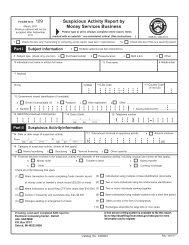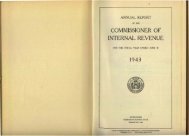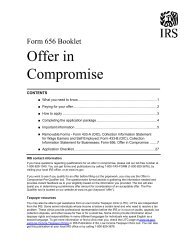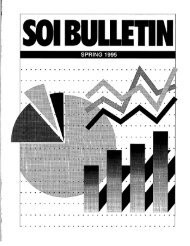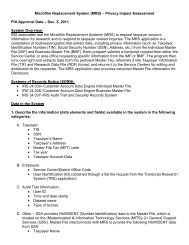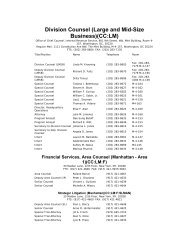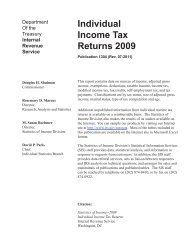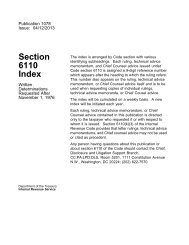Automated Collection System (ACS) - Internal Revenue Service
Automated Collection System (ACS) - Internal Revenue Service
Automated Collection System (ACS) - Internal Revenue Service
You also want an ePaper? Increase the reach of your titles
YUMPU automatically turns print PDFs into web optimized ePapers that Google loves.
<strong>Automated</strong> <strong>Collection</strong> <strong>System</strong> (ACS) – Privacy Impact Assessment (PIA)<br />
PIA Approval Date: December 28, 2009<br />
<strong>System</strong> Overview<br />
ACS is a three-tiered CICS (Customer Information Control <strong>System</strong>) application. The Tier I<br />
computerized inventory system maintains Integrated Data Retrieval <strong>System</strong> (IDRS) balance due and<br />
non-filer cases requiring telephone contact with the taxpayer for resolution. IDRS is controlled through<br />
the Security and Communications <strong>System</strong> (SACS). It is a mission critical steady state system<br />
consisting of databases and operating programs that support IRS employees working active tax<br />
cases within each business function across the entire IRS. Customer <strong>Service</strong> Representatives (CSR)<br />
use ACS case management abilities to contact taxpayers, review their case histories, and issue<br />
notices, liens, or levies to resolve the cases. Taxpayer contact is accomplished through incoming and<br />
outgoing telephone calls via <strong>Automated</strong> Call Distributor (ACD) and through correspondence to<br />
taxpayers and third parties.<br />
<strong>System</strong>s of Records Notice (SORN):<br />
• Treasury/IRS 26.019 Taxpayer Delinquent Account Files<br />
• Treasury/IRS 34.037 IRS Audit Trail and Security Records <strong>System</strong><br />
Data in the <strong>System</strong><br />
1. Describe the information (data elements and fields) available in the system in the following<br />
categories:<br />
A. Taxpayer: Taxpayer information available on ACS relates to a Taxpayer Delinquent Account<br />
(TDA) or Taxpayer Delinquency Investigation (TDI).<br />
• Taxpayer Name<br />
• Taxpayer Address<br />
• Telephone Number<br />
• Taxpayer Identification Number (TIN)<br />
• Date of Birth (DOB)<br />
• Adjusted Gross Income (AGI)<br />
• Telephone Number<br />
B. Employee: Employee information is stored on the system for the purpose of assigning<br />
taxpayer cases, controlling workload, and generating documents and correspondence.<br />
• Employee name<br />
• Employee number<br />
• Office location<br />
• Work telephone number<br />
• Title<br />
• Type of access<br />
• Team Function/Unit<br />
C. Audit Trail Information:<br />
• Date and time of event<br />
• Unique identifier (e.g., employee number and Resource Access Control
Facility (RACF) Identification (ID)<br />
• Type of event<br />
• Subject of the event (e.g., the user, file, or other resource affected)<br />
• Action taken on that subject<br />
• Outcome status (success or failure)<br />
• Date and time of input<br />
D. Other:<br />
• Levy Source Information (third party information)<br />
• Levy Source Name<br />
• Levy Source Address<br />
• TIN<br />
• Levy Source Phone Number<br />
2. Describe/identify which data elements are obtained from files, databases, individuals, or<br />
any other sources.<br />
A. IRS: ACS obtains data from Corporate Files Online (CFOL) system, Integrated Data Retrieval<br />
<strong>System</strong> (IDRS), Inventory Delivery <strong>System</strong> (IDS) and Electronic Levy <strong>System</strong>.<br />
• CFOL provides: DOB and AGI<br />
• IDRS provides: Taxpayer name, Address, TIN<br />
• IDS: Taxpayer Address, telephone number, TIN<br />
• ELS: Levy source information (third party information); levy source name, address, TIN,<br />
and the phone number of the actual levy source.<br />
B. Taxpayer: Case information may be gathered from the taxpayer during an investigation. This<br />
information has to do with the taxpayer's income, expenses, assets and liabilities. Once<br />
gathered, it is keyed into the system by ACS end users.<br />
C. Employee:<br />
• Employee name<br />
• Employee number<br />
• Office location<br />
• Work telephone number<br />
• Title<br />
• Type of access<br />
• Team Function/Unit<br />
3. Is each data item required for the business purpose of the system Explain.<br />
Yes, each data item is required by the system. Each ACS <strong>Collection</strong> Representative (CR) receives<br />
their case inventory electronically based on their team, function, and unit they are assigned. They<br />
work on the cases electronically, i.e. contacting taxpayers, generating correspondence, issuing liens<br />
and levies, and closing cases as necessary. Reports and statistical trends are generated using the<br />
information in the system.
4. How will each data item be verified for accuracy, timeliness, and completeness<br />
ACS has validity checks built into the automated system. Real-time error and Batch errors identify<br />
data entry errors by the CRs.<br />
Validity checks are performed on the data, the action requested, and access to the system. The data<br />
validity and action requested validity is performed while the operator is using the system, and an error<br />
message is displayed which will validate the data entered or action requested. An employee may<br />
receive an error message because they modified a field incorrectly or requested an action that is not<br />
allowed. The error message will be displayed on the screen, and the operator must decipher the<br />
message and correct the error. Until the error is resolved the operator is not able to leave the screen.<br />
No data can be saved until all edits have been performed successfully and an operator has corrected<br />
the problems.<br />
The access validation determines who can get onto the system and once in the system, what<br />
functionalities they can perform. Certain functionalities are accessible for both managers and<br />
employees, and some are reserved for managers only. Certain National Office employees have the<br />
highest access level and are able to modify data that managers in the field cannot.<br />
5. Is there another source for the data Explain how that source is or is not used.<br />
No. There are no other sources for the data outside of the IRS database and systems referenced in<br />
this document.<br />
6. Generally, how will data be retrieved by the user<br />
A user’s inventory of cases is displayed on-screen. A given case in their inventory may then be<br />
selected from the list of cases. The ACS system makes the data available to users on a need to know<br />
basis.<br />
Users have access to specific inventory of taxpayer accounts which is determined when they logon to<br />
the system. Their employee number, team, function, and unit to which they are assigned determine<br />
the access to the inventory. This information is stored in the Security database; only those accounts<br />
to which the user has access to will be displayed.<br />
7. Is the data retrievable by a personal identifier such as name, SSN, or other unique<br />
identifier<br />
Yes. A specific case not part of an employee's assigned inventory may be requested by TIN.<br />
Access to the Data<br />
8. Who will have access to the data in the system (Users, Managers, <strong>System</strong> Administrators,<br />
Developers, Others)<br />
• Computer <strong>System</strong>s Analyst – Level II support for problem resolution. For example, if job is<br />
running and it abends or aborts, and the operations command center cannot resolve the<br />
problem; the problem is sent to the CSA who have Read/Write access to operating system.<br />
• <strong>System</strong> Administrator – Responsible for administering the web server software the<br />
application resides on.<br />
• Operator/DBA User – When a job is released, the Operators mount the tapes. They monitor<br />
the jobs being run. They handle print operations and respond to console messages.<br />
Read/Write access to all application data.
• Application Developers – Application Development is authorized to use ACS with limited<br />
Read/Write access to ad-hoc data for development/testing purposes. Developers do not have<br />
access to production application data. ACS has contractors for the following functions:<br />
Configuration Management, Development, Production Support, etc. Contractors can have the<br />
same roles/responsibilities as internal staff.<br />
• National Office (N) – Superusers. They have full access. They can modify application<br />
parameters.<br />
• Master (M) – Can add users and review parameter tables. Can review audit logs (in Control-D<br />
Web).<br />
• Supervisor (S) – Manager functionality but cannot add users to ACS. Can review audit logs<br />
(Control-D Web).<br />
• Operator (O) – Access taxpayer accounts, issue correspondence, issue levies, issue liens,<br />
etc. Input comments. Add financial information.<br />
• Quality Review (Q) – Someone who views the work performed by Levy Review Operator.<br />
They will only get inventory that has been worked. Quality Review Person can only view<br />
information and are not allowed to modify anything. Same authorization as Manager but<br />
cannot take any LR actions.<br />
• Levy Review Manager (L) – A Levy Review Manager can view/update the work performed by<br />
the Levy Review Operator. They can also access cases that have not been worked and update<br />
them if necessary. Levy Review Manger can access action LR00, LS00 and LI00 action from<br />
the Levy Review Menu. They can access everything under the Manger’s Menu.<br />
• Levy Review Operator (E) – LR operator works on Levy Review Cases which needs to be<br />
resolved. The TE will receive the first case in their inventory when logging to ACS. The case<br />
will be locked and has to be updated prior to getting off the case. The LR Operator will not<br />
have access to LR manager menu.<br />
9. How is access to the data by a user determined and by whom<br />
An ACS CR has access to specific cases via TIN or based on their inventory. Access is granted<br />
based on the duties of the employee, and only on a need-to-know basis.<br />
Form 5081 is required for employees who need to have access to the ACS system as a part of their<br />
official duties. By signing this form, employees indicate their understanding and agreement to abide<br />
by the rules of behavior for accessing sensitive taxpayer data. The Form 5081 ensures that the user<br />
is accountable for any misuse of the system.<br />
10. Do other IRS systems provide, receive, or share data in the system If YES, list the<br />
system(s) and describe which data is shared.<br />
Yes, ACS interfaces with the following applications that send data: Daily Transaction Register (DTR),<br />
Taxpayer Delinquency Investigation (TDI), Taxpayer Delinquent Account (TDA), Centralized<br />
Authorization File (CAF), and Telephone Number Research (TNR).<br />
ACS interfaces with the following applications that receive data: Levy Verification, <strong>Automated</strong> Liens<br />
<strong>System</strong> (ALS), 6020B, Appeals Centralized Database <strong>System</strong> (ACDS), Standardized IDRS/CFOL<br />
Access (SIA on Inventory Delivery <strong>System</strong> box), Integrated <strong>Collection</strong> <strong>System</strong> (ICS)/Access Control
<strong>System</strong> (ACS) Print (IAP), Generalized IDRS Interface (Gll) Server accessed by a <strong>Service</strong> Center<br />
(SC).<br />
The data that is shared includes Corporate File On Line (CFOL), predictive dialer [File Transfer<br />
Protocol (FTP)], Standardized IDRS/CFOL Access (SIA on <strong>Automated</strong> Offers in Compromise (AOIC)<br />
box.<br />
The following text gives an explanation on specific interfaces with each system.<br />
• DTR - Tape comes into ACS and is processed in a job. The DTR tape contains: Taxpayer TIN,<br />
File Source and TIN Type, along with Module Balance. The Taxpayer data is written to ACS<br />
Call Site based on the Area Office / Territory Office AOTO field which specifies which call site<br />
the data belongs. DTR data comes from ICS.<br />
• IDS – Data includes address and telephone information, tax period, TIN, TIN Type and file<br />
source and tax modules.<br />
• TDA - Taxpayer Delinquent Account (TDA) tapes come from IDRS and are processed in a job.<br />
The TDA tape contains TIN numbers, TIN module status, module balance, taxpayer name,<br />
address, phone numbers, spouse name, address, penalty amount, interest accrual amount,<br />
and various indicators.<br />
• TDI - Taxpayer Delinquency Investigation (TDI) tapes come from IDRS and are processed in a<br />
job. The TDI tape contains TIN numbers, TIN module status, module balance, taxpayer name,<br />
address, phone numbers, last amount filed.<br />
• CAF - Telephone number for the Taxpayer is retrieved from the CAF database for those TIN<br />
numbers who have CAF indicator alert set on their account. ACS will update the phone<br />
numbers on their database where Taxpayer data is stored. CAF data provided comes from<br />
IDRS.<br />
• TNR - ACS receives Telephone Response File from IDS that contain the following information:<br />
Home and Work Telephone Numbers, an “Other” Telephone Number where applicable,<br />
information regarding what sources were used for the telephone research and if the telephone<br />
number is unpublished or unlisted. ACS Database is updated with new telephone numbers.<br />
• Appeals ACDS - The user accesses ACS Database directly. The data that is obtained from<br />
ACS includes, Taxpayer information, including TIN, address, Comments made on the account,<br />
Action taken on the account, TDI/TDA Module information, Levy Information, Spousal or Joint<br />
Account information.<br />
• ALS - ACS FTP’s a consolidated file which consists of all the lien information for taxpayers.<br />
The information includes, Taxpayer ID, name, address, forms filed and module balances.<br />
• 6020B - ACS FTP’s a consolidated file on the IDS/A 6020 <strong>System</strong>. This is a program which<br />
creates an extract file with data coming from three ACS databases. The data includes TDA &<br />
TDI Data and Last Period Satisfied (LPS) Data. Specifically the file contains TIN Number,<br />
Taxpayer Name and Address and Phone Numbers. TDI information such as MFT, Module<br />
Credit, Module Tax Period. LPS (Last Tax Period in which that taxpayer compiled with IRS)<br />
data includes Tax Period, LPS amount, Follow up date.
• SIA on IDS Box - ACS FTP’s a consolidated file onto the IDS box. The File contains all the<br />
transfer to queue (TFQU) accounts, which means all accounts that were transferred out of<br />
ACS.<br />
• IAP - ACS generates Letter Data files used to generate Letter Correspondence by Print<br />
<strong>System</strong> that include TIN Number, Taxpayer Address, 3rd Party Address, Module Information<br />
(TDA/TDI), Dollar Amount.<br />
• Gll Server - ACS FTP’s a consolidated file to a <strong>Service</strong> Center. The file is a report of possible<br />
Transfers to Exam. The file contains formatted TIN, Income, Withholding, and Last Return<br />
Filed.<br />
• Levy Verification - ACS creates a tape for upload to SCRS for Levy Verification. The tape<br />
contains Call Site ID, TIN Number, Name, Address, Form Number, Tax Period and Mod<br />
Balance, Tax Liability, Amount Due.<br />
• SIA - Input: SIA on the AOIC box - an Error File is received from SIA onto ACS. It contains<br />
error records that did not upload correctly onto the SIA. Output: SIA on the AOIC box – a file is<br />
EFTU to SIA on the AOIC box. It contains <strong>Service</strong> Center ID, Taxpayer Information such as<br />
Taxpayer ID, Tax Period.<br />
• Predicative Dialer - Input: ACS will receive an Upload; the file contains TIN Number, Home<br />
Phone Number, Work Phone Number and Cell Number and Power of Attorney. Also included<br />
the Number of Attempts made to each number. Output: ACS will EFTU downloaded files,<br />
which includes TIN Number, Case Number, Name Line, Home Phone Numbers, Follow Up<br />
Dates, Module Balance, Form Indicators, Risk Category. Component of the Modernization and<br />
Information Technology <strong>Service</strong>s (MITS)-15 Contact Center General Support <strong>System</strong>.<br />
• CFOL - Input: ACS will receive a Third Party Contact Error EFTU file from CFOL and produce<br />
and Error Report. The file contains the TIN Number, address, phone number, Error message.<br />
Output: ACS will EFTU two files to CFOL. The file contains TIN Number, Plan Number,<br />
Secondary TIN, Primary and Secondary Contact Indicators, Contact Date, Third Party Name,<br />
Address and Telephone Number and Tax Year. Input: ACS will receive two EFTU files for each<br />
of the 10 <strong>Service</strong> Centers. The two files contains of SCOP (Standard CFOL Overnight<br />
Processing) and a control file. The data in those files include TIN, MFT-CD, and Tax Period.<br />
IMF or BMF Data. Output: ACS will EFTU two files to CFOL, which contains Data and Control<br />
Information. Specifically, the files contain TIN number, multiple indicators such as IRMF, NAP<br />
BMF, IMF, EPMF, and BRTF and related data for each items mentioned above.<br />
11. Have the IRS systems described in Item 10 received an approved Security Certification and<br />
Privacy Impact Assessment<br />
Yes. The following systems received an approved Security Certification and Privacy Impact<br />
Assessment. <strong>System</strong>s not listed here are considered non-applications.<br />
AOIC<br />
• PIA completed on 3/27/2007<br />
• C&A completed on 6/7/2007<br />
IDRS<br />
• PIA completed on 11/6/2008<br />
• C&A completed on 4/2009
Appeals ACDS<br />
• PIA completed on 1/10/2008<br />
• C&A completed on 4/1/2008<br />
ALS<br />
• PIA completed on 4/10/2007<br />
• C&A completed on 2/21/2008<br />
6020B<br />
• PIA completed on 6/4/2007<br />
• C&A completed on 7/30/2007<br />
ELS<br />
• PIA completed on 8/28/2007<br />
• C&A completed on 5/22/2008<br />
IAP<br />
• PIA completed on 5/1/2007<br />
• C&A completed on 9/11/2007<br />
IDS<br />
• PIA completed on 9/10/2008<br />
• C&A completed on 5/1/2009<br />
ERS<br />
• PIA completed on 2/27/2009<br />
• C&A completed on 5/11/2009<br />
Standardized IDRS Access (Tier II)<br />
• PIA completed on 3/28/2008<br />
• C&A completed on 6/13/2008<br />
MITS-15 Contact Center GSS<br />
• PIA Completed on 6/9/2009<br />
• C&A Completed on 9/24/2007<br />
• DTR is a tape (Stated in Question 10)<br />
• TDA comes from IDRS (Stated in Question 10)<br />
• TDI comes from IDRS (Stated in Question 10)<br />
• CAF comes from IDRS (Stated in Question 10)<br />
• TNR comes from IDRS (Stated in Question 10)<br />
• Predicative Dialer Input (Part of the MITS-15 GSS. Does not have its own C&A or PIA Date)<br />
• GII Server (Non-Application)<br />
• Levy Verification (Non-Application)<br />
• CFOL (Non-Application)<br />
12. Will other agencies provide, receive, or share data in any form with this system<br />
No. Other agencies will not provide, receive, or share data in any form with ACS.
Administrative Controls of Data<br />
13. What are the procedures for eliminating the data at the end of the retention period<br />
When a taxpayer case is closed, the closing information is made part of the taxpayer records of IDRS<br />
and Masterfile. The case is maintained on the Mainframe as an archived case for 2 years in<br />
accordance with IRM 1.15.28-1, part V.<br />
14. Will this system use technology in a new way<br />
No. ACS will not use technology in a new way.<br />
15. Will this system be used to identify or locate individuals or groups If so, describe the<br />
business purpose for this capability.<br />
Yes. The CRs use ACS case management abilities to contact taxpayers, review their case histories,<br />
and issue letters, liens, or levies to resolve cases.<br />
16. Will this system provide the capability to monitor individuals or groups If yes, describe<br />
the business purpose for this capability and the controls established to prevent unauthorized<br />
monitoring.<br />
ACS has the ability to monitor employee workloads and actions taken on cases. For that purpose, the<br />
manager has a security profile and can view and monitor individuals or groups of employees. The<br />
ACS system is not used to monitor individual taxpayers or groups.<br />
17. Can use of the system allow IRS to treat taxpayers, employees, or others, differently<br />
No. Use of this system does not permit the disparate treatment of individuals or otherwise deny any<br />
rights they may have by law, including rights to appeal assessments or other decisions that may be<br />
statutorily contested.<br />
18. Does the system ensure "due process" by allowing affected parties to respond to any<br />
negative determination, prior to final action<br />
Yes. Checks are built in to the system to prevent premature or inappropriate actions. Taxpayers are<br />
still entitled to the same appeal rights as other taxpayers whose cases are not worked in the ACS<br />
system.<br />
19. If the system is web-based, does it use persistent cookies or other tracking devices to<br />
identify web visitors<br />
Not applicable. The ACS system has a web- module front-end but the entire ACS system is not webbased.<br />
View other PIAs on IRS.gov


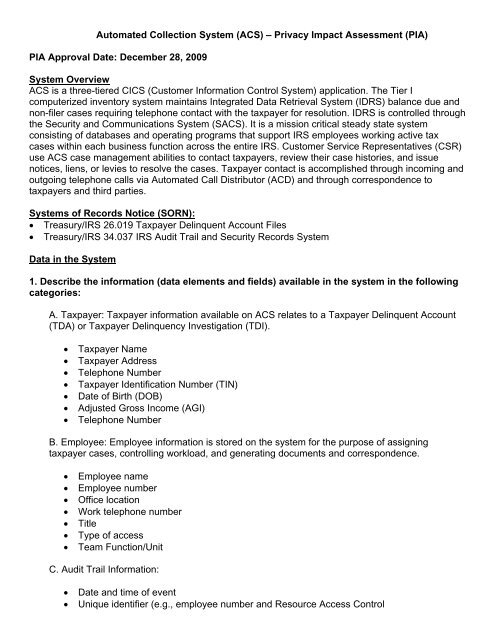
![l..l.l.L. 4DB.DI3-l]t] xxxxxxxxxxxxxxxx - Internal Revenue Service](https://img.yumpu.com/51302394/1/190x245/llll-4dbdi3-lt-xxxxxxxxxxxxxxxx-internal-revenue-service.jpg?quality=85)

